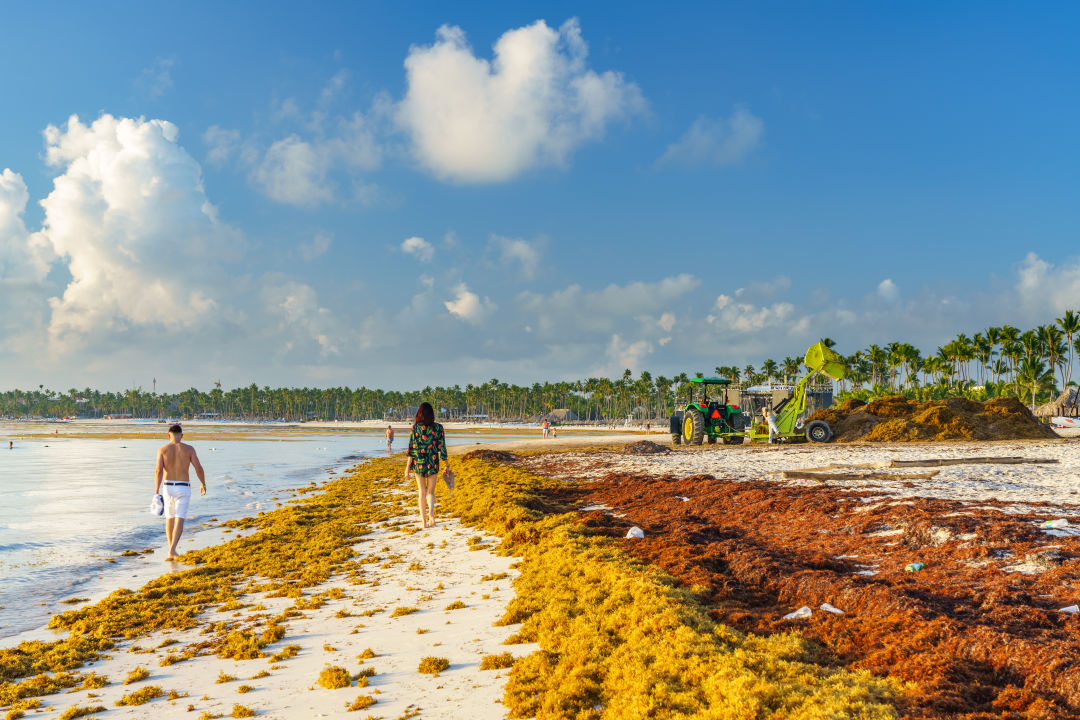That Huge Sargassum Bloom Is Filled with Plastic and Possibly Deadly Bacteria

A white-sand beach during a previous sargassum event.
Back in March, we were warned that an impending 5,000-mile-long sargassum bloom could overwhelm Florida’s coast this summer. Whoever is scripting 2023 decided that millions of tons of rotting seaweed covering our beaches wasn’t enough and has now added plastic-loving, flesh-eating bacteria to the horror film that is Florida in the 21st century.
A recent study by Florida Atlantic University researchers shows that there are massive quantities of plastic floating alongside this historic sargassum bloom, and that the plastic encourages the presence of the deadly flesh-eating bacteria Vibrio vulnificus.
Dr. David Tomasko, executive director of Sarasota Bay Estuary Program, says this is a result of the sargassum originating from a different part of the Atlantic Ocean than it usually does. “It’s concerning because sargassum is arriving in much greater abundance than it has historically, because it’s coming from what’s called the Great Sargassum Belt instead of the Sargasso Sea,” he explains. The Sargasso Sea is in an isolated gyre further north than the belt that stretches between the Gulf of Mexico and the coast of West Africa, and it receives fewer nutrients.
This past year, the Great Sargassum Belt became historically large. “It’s fed with nutrients from coastal upwelling off of Africa, from runoff from the Orinoco River, the Amazon and the Mississippi, so there’s a lot more sargassum biomass, which means there’s a lot more material for bacteria to feed upon," Tomasko says.
He adds that the bacteria’s interaction with all the plastic entangled in the sargassum adds a concerning new variable to the already troubling crisis. “The study shows that there is a bacterial film on the plastic containing high levels of bacteria, probably because the plastic does not degrade and sticks around for a long time, unlike the sargassum,” he says. “The bacterial film on the plastic particles seems to be pretty high with the genus Vibrio.” Vibrio bacteria is famous for deadly species like Vibrio cholerae, the bacteria that causes cholera, but the species that most concerns Tomasko is Vibrio vulnficus.

Sargassum.
Vibrio vulnficus is the same bacteria found in oysters that can make you violently ill, but it's especially concerning when the bacteria comes into contact with open wounds. The bacteria has a 20 percent mortality rate. Tomasko pointed to the several deaths at Lee County beaches earlier this year after Hurricane Ian
flushed Vibrio-laden water into the Gulf. “There was a really heartbreaking story of a volunteer who came down from Michigan to help clean up after Ian,” Tomasko says. “He cut himself in the water and died in three days. So, yeah, this is really not a good thing.”
Fortunately, the sargassum hasn’t reach our Gulf beaches yet. But we've just entered hurricane season, and a big storm could push the unwelcome seaweed to our shores. There’s an old wives' tale that says you shouldn’t eat oysters during months that don’t contain the letter 'R'—May through August. These are the hottest months and they allow for the most bacterial growth. Does this mean we shouldn’t swim in the sea during those same months, especially as our summers get longer and hotter?
The sargassum has now reached the east coast and many of the Caribbean islands. “I saw video of the sargassum on Fisher Island in Miami,” says Tomasko. “You would be well advised to not go into that water.”
But Tomasko says the seaweed doesn’t mean you have to stay out of the water entirely. Sargassum and bacteria have always been around, but there are a few things to look out for. If you are healthy enough, your body can likely stave off low doses of these bacteria. But if you have a cut, scrape or you cut yourself in the water, don’t risk it.

Sarasota Bay Estuary Program executive director Dave Tomasko says not to wade through thick, smelly sargassum.
Image: Shuttershock/S.Borisov
“If you wade through a thin layer of sargassum, that’s not such a big deal,” Tomasko says. “But if you go through a pile of sargassum and it feels warm and scratchy and it smells bad, that is probably a bacterial soup and it's not a good idea.”
It’s unclear how this story is going to end. We could be dealing with dangerous sargassum blooms on a yearly basis. Tomasko says this is what happens when we treat our oceans like a dump. “In a way," he says, "it’s kind of like nature is fighting back.”



